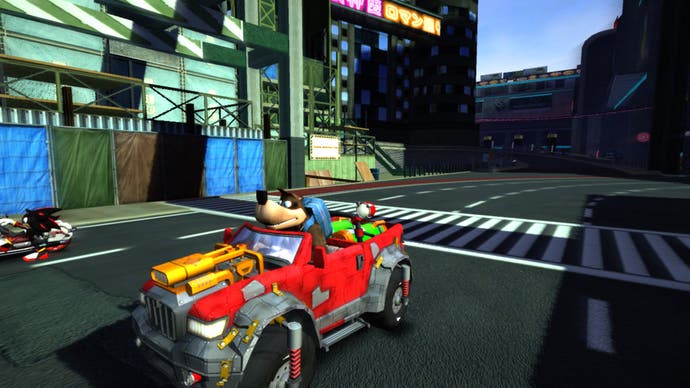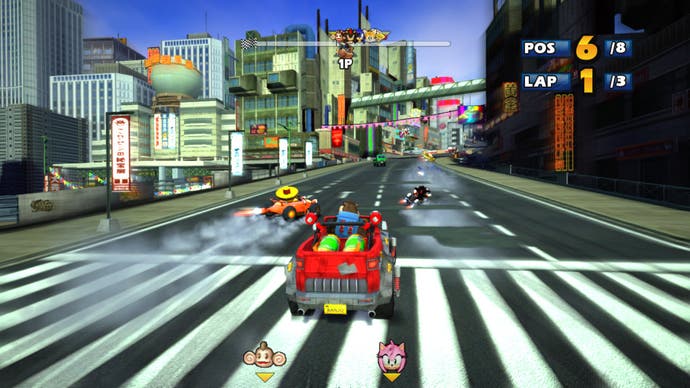Xbox 360 vs. PlayStation 3: Round 25
Episodes from Liberty City, SSFIV, SEGA All-Stars Racing, Superstars V8, Dead to Rights and AVP.
Sonic and SEGA All-Stars Racing
| Xbox 360 | PlayStation 3 | |
|---|---|---|
| Disc Size | 3.8GB | 3.87GB |
| Install | 3.8GB (optional) | - |
| Surround Support | Dolby Digital | Dolby Digital, 5.1LPCM, 7.1 LPCM |
It's good to know that there's a talented developer team out there that still "gets" what SEGA used to be about: the brilliant characters, the simple but hugely enjoyable gameplay, the sheer blue skies of it all. It's just rather odd that it's Sumo Digital that is now seemingly the custodian of the SEGA heritage while the parent company itself has all but jettisoned its past and once again finds itself contemplating another period of transition.
While it's difficult to argue with many of the points in Dan Whitehead's original review, there's something you can't avoid with Sonic & SEGA All-Stars Racing - it's simply great fun to play, with some lovely course layouts. Sure, it lacks the attention to detail and basic genius of its Nintendo karting counterpart, but within the admittedly narrow parameters of what makes a really cool arcade-style SEGA game, it's lovely stuff.
So... PlayStation 3 or Xbox 360? That's where things get tricky. Let's start with the basic comparison footage, based on both versions featuring the latest game patches.
On the face of it, it's clearly very much the same game, albeit with some additional visual refinements on Xbox 360. Chief among these (at speed) is a muted but effective motion blur, but more obvious is a detail-sapping bloom. Both games are anti-aliased, with 360 using the traditional 2x MSAA, while PS3 uses what seems to be a more selective implementation of Quincunx.
While the latter adds more blur, this is not really an issue with this style of visual (and Sumo did the same thing in its SEGA Superstars Tennis game). Texture filtering also appears to be marginally superior on 360, though away from a frame-by-frame analysis there really is virtually nothing in it.
Perhaps the most impactful aspect of the comparison is the far more apparent screen-tearing on Xbox 360 - and this is where things get odd. Screen tear has been added to both versions of the game via the latest patches. Both of them shipped v-synced, but this did cause some performance issues, clearly causing Sumo to re-think the situation.
In common with many games, Sonic & SEGA All-Stars Racing is double-buffered. Basically what this means is that while one frame is being displayed, the next frame is being generated behind the scenes, the framebuffer is flipped and the process starts anew. However, what this means is that should your frame-rate dip below 30FPS, processing effectively stalls, with immediately noticeable dips to 20FPS. F.E.A.R. 2 and Metal Gear Solid 4 on PS3 are two good examples of this.
The same thing happens, or rather happened, in Sonic & SEGA All-Stars Racing. Recent patches for both versions of the game have changed this and in this regard it is the PlayStation 3 code that produces the best solution.
What we're seeing here is the more traditional solution to dropped frames. Rather than maintain v-sync and drop down heavily to 20FPS should frame-rate dip, tearing is introduced - hopefully only fleetingly - and response from the controls doesn't drop so much. There are issues with some tracks more than others (the House of the Dead circuit in particular is rougher than many of the others).
This is a decent enough compromise, but what Sumo has done with the Xbox 360 version isn't quite so successful, as this performance analysis reveals.
Here frame-rate isn't being capped at 30FPS - it's running completely unlocked, meaning that screen-tear is ever-present and very impactful on overall image quality. Average frame-rates clearly increase but it is at the expense of a more solid look and feel that you get with the patched PS3 game.
Horses for courses really: some may prefer the higher frame-rate, but you can't help wish that Sumo had used the same approach that they had for the PS3 patch in order to maintain visual consistency for most of the time. It's the only thing that stops us from recommending the 360 build over the PS3 version. We've already highlighted some of the other differences which on balance give the 360 game the nod. But it's also worth pointing out that the Microsoft platform gets a bit more content too.


While hardly likely to overly impact any purchasing decision, the Xbox 360 version of the game does include Banjo and Kazooie as a karting double-act, and there's also the option to include the much under-used and somewhat ignored (until Natal comes out) Avatars in-game.
Reservations apart, some good times were had playing this game, and bearing in mind the relatively lightweight use of the DVD and Blu-ray, maybe Sonic & SEGA All-Stars Racing could attract more success somewhere down the line as a keenly priced PSN and Xbox Live Marketplace download.







